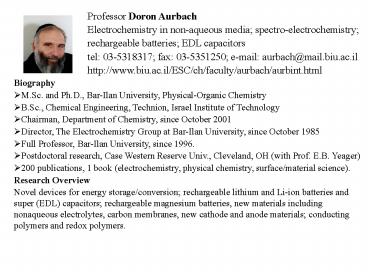Professor Doron Aurbach - PowerPoint PPT Presentation
1 / 5
Title:
Professor Doron Aurbach
Description:
... patterns and TEM micrograph which characterize the nanocrystalline ... The synthesis produces also electroactive carbon nanoflasks, as seen in the micrograph. ... – PowerPoint PPT presentation
Number of Views:155
Avg rating:3.0/5.0
Title: Professor Doron Aurbach
1
- Professor Doron Aurbach
- Electrochemistry in non-aqueous media
spectro-electrochemistry - rechargeable batteries EDL capacitors
- tel 03-5318317 fax 03-5351250 e-mail
aurbach_at_mail.biu.ac.il - http//www.biu.ac.il/ESC/ch/faculty/aurbach/aurb
int.html - Biography
- M.Sc. and Ph.D., Bar-Ilan University,
Physical-Organic Chemistry - B.Sc., Chemical Engineering, Technion, Israel
Institute of Technology - Chairman, Department of Chemistry, since October
2001 - Director, The Electrochemistry Group at Bar-Ilan
University, since October 1985 - Full Professor, Bar-Ilan University, since 1996.
- Postdoctoral research, Case Western Reserve
Univ., Cleveland, OH (with Prof. E.B. Yeager) - 200 publications, 1 book (electrochemistry,
physical chemistry, surface/material science). - Research Overview
- Novel devices for energy storage/conversion
rechargeable lithium and Li-ion batteries and
super (EDL) capacitors rechargeable magnesium
batteries, new materials including nonaqueous
electrolytes, carbon membranes, new cathode and
anode materials conducting polymers and redox
polymers.
2
New materials (novel anodes, cathodes,
electrolytes) for rechargable batteries and
supercapacitors
For example Nanospinel LiMn2O4 as a Cathode
Material for Li Batteries
3
Multiwall Carbon Nanotubes for Anodes
Nanomaterials as active mass of electrodes for
rechargeable Li batteries.
TEM micrographs of carbon MWNT. Two types of
nanotubes, short (0.5 microns) and long (over 5
microns) can be observed. Their thickness is
between 50 to 150 nm with an average diameter of
40 nm. Cobalt nanorods are embedded inside the
nanotubes. The synthesis produces also
electroactive carbon nanoflasks, as seen in the
micrograph.
Reproducible electrochemical response
The electrochemical behavior of composite
electrodes, comprised of multiwall carbon
nanotubes. The pressure applied to the electrodes
during their preparation plays a major role on
their performance because it influences the
contact between the solution and the active mass.
a-unpressed electrodes. b-pressed electrodes.
4
Nanotechnology for Energy Storage and Conversion
Rechargeable Mg batteries because Mg is light,
abundant and environmentally benign (green).
Current status Nominal voltage 1.1V(single
cell), Theoretical energy density 135 Whr/Kg,
materials utility gt85, cycle life gt 3500, low
self discharge, a wide temperature range.
Why nanomaterials? Ideal for high rate of
operation and fast response.
Applications remote location requiring
maintenance-free operation, low self discharge
and excellent cycle-ability.
5
Carbon engineering
Nano porous carbons
Why nano? high surface area with high
selectivity, specific well designed
electrode-solution interactions.
Novel high energy density and fast Li ion
batteries.
Highly selective membranes for fuel cells.
Highly fast power sources Super
EDL capacitors
Organic Precursors
Carbonization
Activation
Controlled nano porosity
Nano pores
New anodes for Li ion batteries high capacity
better than that of graphite
Nano particles
Super capacitors Highly fast devices, unlimited
cycleability
Direct methanol fuel cells
High voltage super capacitors with organic
solutions































